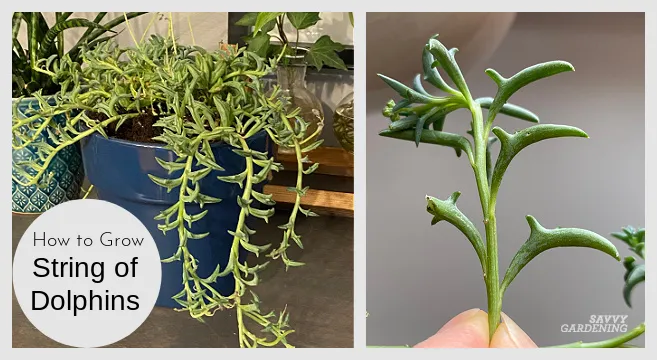String of Dolphins:
Discover the fascinating String of Dolphins plant, including its care, propagation, and benefits. Learn how to grow and enjoy this unique succulent in your home.
Introduction
The String of Dolphins, scientifically known as Senecio peregrinus, is a captivating succulent that has gained immense popularity among plant enthusiasts. Its unique, dolphin-shaped leaves make it a delightful addition to any plant collection, providing both aesthetic appeal and easy care requirements. This article delves into everything you need to know about this charming plant, from its origins and characteristics to care tips and propagation methods.
What is String of Dolphins?
String of Dolphins is a hybrid succulent, a cross between the String of Pearls (Senecio rowleyanus) and the Candle Plant (Senecio articulatus). The plant’s leaves resemble tiny dolphins jumping out of the water, hence the name. This distinctive appearance has made it a favorite among succulent collectors and interior decorators alike.
Origins of String of Dolphins
The String of Dolphins is a relatively new hybrid in the succulent world. It was created by crossbreeding two well-known succulent species, resulting in a plant that combines the best traits of both parents. Its origins can be traced back to botanical experiments aimed at developing unique and visually appealing plants for the horticulture market.
Scientific Classification
The String of Dolphins belongs to the Asteraceae family, which includes a wide variety of flowering plants. Its genus, Senecio, encompasses a diverse group of plants known for their unique foliage and resilience. The specific epithet, peregrinus, translates to “wandering,” reflecting the plant’s trailing growth habit.
Characteristics of String of Dolphins
Unique Dolphin Shape
One of the most striking features of the String of Dolphins is its leaves, which resemble tiny dolphins leaping out of the water. Each leaf is fleshy and curved, creating the illusion of a pod of dolphins swimming along the stems. This unique shape not only adds a whimsical touch to the plant but also makes it a conversation starter in any plant collection.
Growth Habit
The String of Dolphins grows as a trailing succulent, with stems that can reach up to three feet in length. These stems are adorned with the signature dolphin-shaped leaves, creating a cascading effect that looks stunning in hanging baskets or pots placed on high shelves.
Blooming Season
While the foliage is the main attraction, the String of Dolphins does produce small, white, or light pink flowers. These blooms typically appear in the late spring to early summer and add an extra layer of charm to the already enchanting plant.
Ideal Growing Conditions
Light Requirements
String of Dolphins thrives in bright, indirect light. It can tolerate some direct sunlight, especially in the morning, but too much intense light can scorch the leaves. Placing the plant near a south-facing window with filtered light is ideal.
Watering Needs
Like most succulents, String of Dolphins prefers infrequent watering. The soil should be allowed to dry out completely between waterings to prevent root rot. During the growing season (spring and summer), water thoroughly but sparingly. In the dormant season (fall and winter), reduce watering significantly.
Soil Preferences
A well-draining soil mix is crucial for the health of String of Dolphins. A commercial cactus or succulent mix works well, or you can create your own blend by mixing regular potting soil with sand or perlite to improve drainage.
Temperature and Humidity
String of Dolphins prefers moderate temperatures, ranging from 60°F to 80°F (15°C to 27°C). It can tolerate occasional temperature drops but should be protected from frost. Average household humidity levels are sufficient, as the plant is adapted to dry environments.
Potting and Repotting
Potting String of Dolphins in a container with drainage holes is essential to prevent waterlogged soil. Repotting should be done every couple of years or when the plant outgrows its current container. Choose a pot that is only slightly larger than the previous one to avoid excess moisture retention.
How to Care for String of Dolphins
Watering Schedule
Establishing a consistent watering schedule is key to maintaining a healthy String of Dolphins. Water the plant thoroughly, allowing water to drain out of the bottom of the pot. Ensure the soil is completely dry before the next watering, and reduce watering frequency during the plant’s dormant period.
Fertilization Tips
Fertilize String of Dolphins sparingly, using a balanced, water-soluble fertilizer diluted to half strength. Apply the fertilizer during the growing season, typically once a month, and avoid fertilizing during the dormant winter months.
Pruning and Maintenance
Pruning is not typically necessary for String of Dolphins, but you can trim back leggy or overgrown stems to maintain a tidy appearance. Pruned sections can be used for propagation, making it easy to expand your collection.
Common Pests and Diseases
String of Dolphins is relatively pest-resistant, but it can occasionally be affected by common succulent pests such as mealybugs and aphids. Regularly inspect the plant for signs of infestation and treat promptly with insecticidal soap or neem oil. Overwatering can lead to root rot, so ensure proper watering practices.
Propagation of String of Dolphins
Propagation from Cuttings
Propagating String of Dolphins from cuttings is the most popular method. Simply cut a healthy stem section and allow it to callus over for a few days. Once callused, place the cutting in well-draining soil and water sparingly until roots develop.
Propagation from Seeds
While less common, propagation from seeds is possible but requires patience. Sow seeds in a well-draining soil mix and keep them lightly moist until germination. This method can take several weeks to months, so it is best suited for experienced growers.
Propagation Tips and Tricks
For best results, propagate String of Dolphins during the growing season when the plant is most active. Ensure cuttings are taken from healthy, mature stems, and provide a warm, bright environment to encourage root development.
Benefits of Growing String of Dolphins
Aesthetic Appeal
The primary benefit of String of Dolphins is its unique and attractive appearance. The dolphin-shaped leaves add a whimsical and decorative touch to any space, making it a perfect choice for plant enthusiasts and interior decorators.
Air Purification
Like many succulents, String of Dolphins contributes to air purification by removing toxins from the air and releasing oxygen. This makes it a beneficial addition to your home environment.
Low Maintenance
String of Dolphins is a low-maintenance plant, ideal for busy individuals or those new to gardening. Its minimal watering and care requirements make it an easy-to-grow option for anyone looking to add some greenery to their space.
Decorating with String of Dolphins
Indoor Display Ideas
String of Dolphins looks stunning in hanging baskets, where its trailing stems can cascade down elegantly. It can also be placed on high shelves or in macramé hangers to create a vertical garden effect.
Outdoor Display Ideas
While primarily an indoor plant, String of Dolphins can be grown outdoors in containers or hanging baskets during the warmer months. Ensure it is placed in a shaded or partially shaded area to protect it from harsh sunlight.
String of Dolphins in Terrariums
String of Dolphins can be a charming addition to succulent terrariums. Its trailing habit and unique leaf shape provide contrast and interest when combined with other small succulents and decorative elements.
String of Dolphins FAQs
How often should I water String of Dolphins?
Water String of Dolphins thoroughly but infrequently, allowing the soil to dry out completely between waterings. Reduce watering in the dormant winter months.
Can String of Dolphins tolerate direct sunlight?
While it can tolerate some direct sunlight, String of Dolphins prefers bright, indirect light. Too much direct sunlight can scorch its leaves.
What type of soil is best for String of Dolphins?
A well-draining soil mix, such as a commercial cactus or succulent mix, is ideal for String of Dolphins. You can also mix regular potting soil with sand or perlite.
Conclusion.
Propagate String of Dolphins from stem cuttings by allowing them to callus over before placing them in well-draining soil

